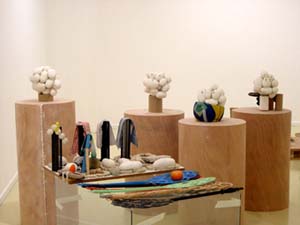In Dr. Seuss’s story which Golombek reads to his daughter, Gaya, one type of Sneetch (Snitz in Hebrew) braggingly confronts the other type solely by virtue of its star-belly.
“I present what you wouldn’t bother picking up from the floor, and if you do pick it up – you are a part of the work,” he says. The floor installation is chatty and outmoded. It is not about a romanticism of obsolete things; there is no air of nostalgia here. The constituent elements are crammed together, creased; survivors.
Golombek’s order is built of sensibilities – the literariness of the soap in faded plastic color and a cut grandfather-collar. Golombek arranges forms and objects closed within themselves – potato casts, a drop, a tooth, an egg, a tear, film cans, ping-pong balls, meringue kisses; butts remain, however; shnitzim in Yiddish: lighters, egg crates on easels, chewed pencils. The installation appears at once exact and improvised.
The various installations – the clusters, piles and displays – are arranged like streets, acquiring their names from the names of the streets in the neighborhood where the artist lives and works: the shnitzim of Chlenov, Levinsky, Matalon, Har Tsion Blvd. Each street has its own specialty: Matalon is the toy street, Herzl – the furniture street, Levinsky – the spice street. It is an area of immigrants and labor. Golombek does not seek the hidden beauty in the object he exhibits. “It is a poor man’s hope,” he says. Lighters are arranged on egg crates, flickering. One minute it is a moving installation, and the next minute – a mere pile of lighters on egg crates.
Less Reading...
